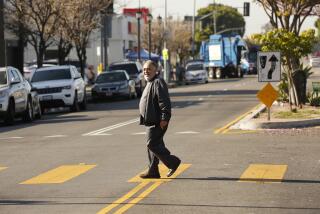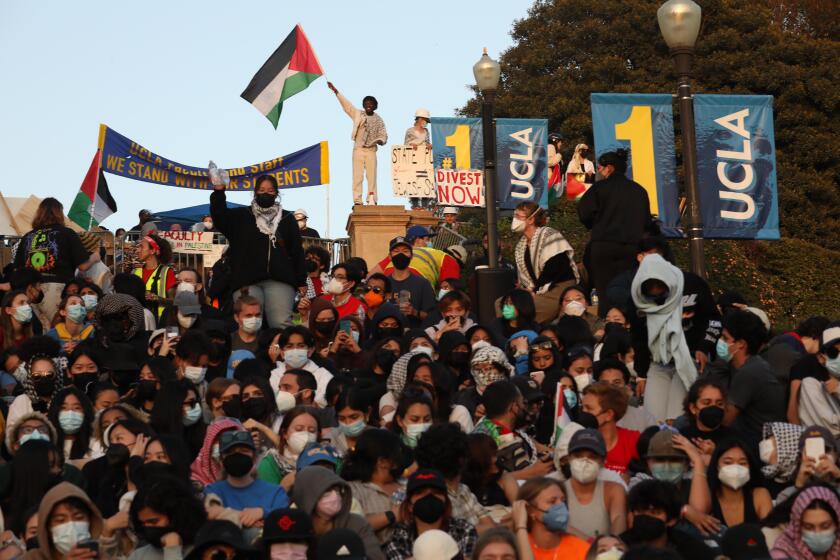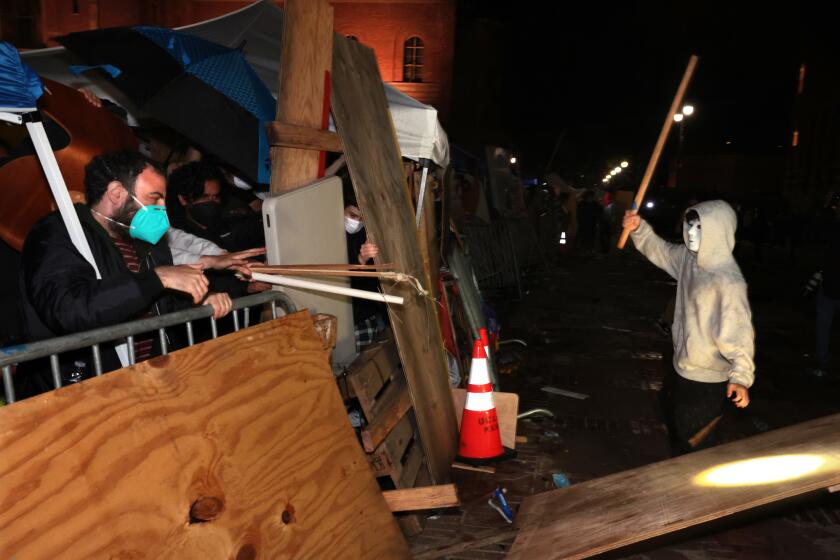Navigating a safe path to schools surrounded by homicide: by foot, by bus, by car
In the most dangerous neighborhoods in Los Angeles, thousands of students must navigate safe paths to and from school — traveling through multiple gang territories amid threats of robbery, harassment, sexual assault, kidnapping and other hazards.
Dymally High School, in Green Meadows, and Hawkins High School near Harvard Park are among the public high schools in Los Angeles County surrounded by the most homicides, according to an analysis by The Times.
Students have few transportation options. The Los Angeles Unified School District offers limited busing, mostly for students attending district schools outside of their communities. Many must walk to school, while others take public buses or private ride shares when family members are unable to drive them.
Here are three students’ journeys to school: by foot, by bus and by car.
Carl Hull, 10th grade, Dymally High School
7:21 a.m.: Carl leaves his apartment and turns into the alley between 89th and 90th streets. He takes the alley because it’s slightly faster, but also because he doesn’t want to catch the attention of gang members on his street. Police urge students to walk in pairs and avoid small side streets and alleys. Carl walks alone down this alley, lined with rusted fences, trash and patches of grass, every school day.
The previous day, he said, he found a 9-millimeter bullet casing in the alley. “I picked it up with my shirt,” he said, whispering as he pointed to the spot in the dirt where he had found and left the casing. The week before, while at home with his mother, he heard 30 to 40 gunshots. He didn’t report them to police, and the LAPD said it had not received reports of gunfire or injuries on the block. Often, gunfire will only be recorded in cases of injury or death.
“I don’t know if anyone got hit, but all I heard was: pow pow pow pow pow, a few seconds they would stop, reload, pow pow pow pow pow pow pow, stop, reload, pow pow pow, pow,” he said.
Near Knox Elementary School, Carl heads east on 90th Street, because that’s where he’s encountered the fewest aggressive dogs. After being chased multiple times on other streets, he is afraid of canines, and his walk to school is filled with their barking.
There is a crosswalk at 90th and Main, but sometimes the light takes too long, so Carl jaywalks even though he worries about his safety. In 2016, his older brother was killed in a hit-and-run while crossing the street near their home. The driver has not been found.
7:35 a.m.: Carl passes Green Meadows Recreation Center, where he often plays basketball after school with friends. There are fights at night sometimes, and during one summer event at the park in 2017 he saw someone waving a gun.
7:38 a.m.: Carl arrives at Dymally. He likes to get to school well before first period, to give himself time to watch funny videos on his phone and decompress.
Carl knows he has to be careful on his way to school, and he knows people his age have been killed. Between 2014 and 2018, 10 teens ages 13 to 18 were killed within a mile radius of Dymally.
Later in the fall, Carl started riding a bike to school.
“It’s not fair and it’s not your choice whether or not to take somebody’s life. It’s, like, they don’t deserve to get killed.”
Isabella Mejia, ninth grade, Community Health Advocates School at Hawkins High School:
Ninth-grader Isabella usually leaves her home around 7 a.m. for the 10-minute walk to the bus stop on Vermont Avenue.
Traffic is loud and close — but Isabella tries to focus on the pleasant things she sees. “I just like to look at the trees, birds, the people,” she said. She rarely sees other high school kids on the same route. Only before reaching Vermont, the busiest street on her journey, does she pull out her phone to check the bus schedule. She doesn’t want to be distracted by anything that could make her late. Her mom says she taught Isabella to always be aware of her surroundings.
Isabella takes public transit because LAUSD buses serve only a small percentage of high school students, most of whom have special needs or attend schools farther away. Isabella does not qualify but has a few options for Metro buses. She prefers the 754 because it gets her close to school in one stop. She pays $1.75 in bus fare each way. Though she could buy a discounted student TAP card, but her mom hasn’t had time to complete the application, she said.
7:18 a.m.: On the bus, Isabella takes a window seat near the exit door and reads comics on her phone.
7:22 a.m.: Isabella hops off the bus at the Vermont/Slauson stop. Here, she joins many students walking mostly to either Muir Middle School, to her right, or to Hawkins. As she passes Muir, a man in a pickup truck yells, “Ay, mami!” in the direction of Isabella and other girls. No one responds. He honks — two short bursts — and shouts, “Ay, mami!” again. Such catcalls are common, Isabella said.
“If it happens, I just ignore it,” she said.
Isabella passes a strip mall near campus where in 2017 Hawkins student Kevin Cleveland was gunned down after he and a group of friends were accosted by a shooter who asked if they were gang members. Isabella said she hasn’t heard anything about the reputation of this strip mall, but she never stops at any of the shops after classes — her mom says she must come straight home, to stay safe.
“She would get mad at me if I went anywhere else.”
7:32 a.m: Isabella arrives at Hawkins, where students are greeted by youth intervention workers — former gang members respected by students and others in the community. The workers, members of the nonprofit organization Chapter Two, are also at the campus at lunch and after school, and share information with administrators about conflicts in the community that might spill into school. Major streets around the campus are also patrolled as part of a community policing program.
In the first few weeks of school, Isabella rarely noticed these patrols meant to help her feel safe, she said.
”I go on my own.”
Cheyenne Boone, 10th grade, Dymally High School
6:08 a.m.: Cheyenne and her mother, Angela Gant, usually pull out of their apartment complex in Harvard Heights when it’s still dark. Cheyenne watches “Gossip Girl” on her phone as Gant makes the nearly nine-mile drive to her mother’s home a few blocks from Dymally.
On Manchester Avenue, off the 110 Freeway, is the place where two high school students, Monyae Jackson and La’marrion Upchurch, were shot and killed in May. Cheyenne and Monyae were friends, and she remembers him as funny and nice to be around. It’s weird for her to pass the spot where he was killed every weekday and see faded memorials to him and La’marrion on the wall.
“Every time we pass that street, I look at the storage place where they got shot,” Cheyenne said. “Sometimes you could still see the graffiti, because they didn’t paint everything over.”
6:24 a.m.: They reach Cheyenne’s grandmother’s house near 92nd and San Pedro streets. This is where Cheyenne stays until she walks to school, and where she comes to nap or do homework after school until her mother picks her up for dance class.
Despite the surrounding violence, Gant sends Cheyenne to Dymally because it is on her way to work and there is family nearby.
“I’m not surprised by it. I wish it was different,” Gant said of the killings. “I worry every day.”
7:54 a.m.: Cheyenne leaves her grandmother’s house, says bye to the dog, Thunder, and walks toward San Pedro Street. She’s cutting it close — class starts at 8 a.m. Usually, she times her walk so that she’ll get to school by 7:59 or 8 a.m. exactly, because this is her first year at the school and she doesn’t feel like she has many friends yet.
She misses her old school, Foshay Learning Center, where she knew other students well and felt on track to apply for Harvard University, her dream school.
8:02 a.m.: Though it’s just a few blocks, the plan to get through the gates in the nick of time doesn’t quite work. The day before, the school began checking the backpacks of every tardy student as a way to deter them from arriving late. The delay is a few minutes, and then Cheyenne is inside and on her way to P.E.
She tries not to be too isolated coming and going from class.
“Usually when I walk to school and walk home, a bunch of other kids are going that way or coming from that way, so it’s like I see a bunch of kids, so that’s why I feel safe,” she said. “If anything were to happen, there’s witnesses.”
Reach Sonali Kohli at Sonali.Kohli@latimes.com or on Twitter @Sonali_Kohli.
More to Read
Start your day right
Sign up for Essential California for news, features and recommendations from the L.A. Times and beyond in your inbox six days a week.
You may occasionally receive promotional content from the Los Angeles Times.







